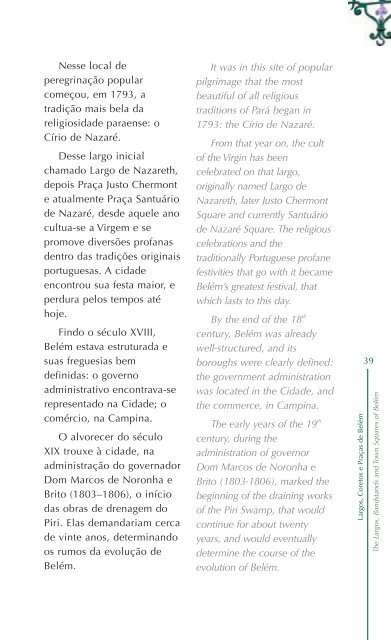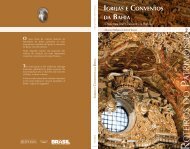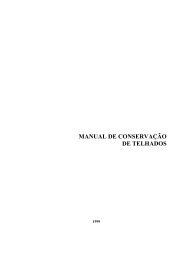LARGOS, CORETOS E PRAÇAS DE BELÉM - Monumenta
LARGOS, CORETOS E PRAÇAS DE BELÉM - Monumenta
LARGOS, CORETOS E PRAÇAS DE BELÉM - Monumenta
Create successful ePaper yourself
Turn your PDF publications into a flip-book with our unique Google optimized e-Paper software.
Nesse local de<br />
peregrinação popular<br />
começou, em 1793, a<br />
tradição mais bela da<br />
religiosidade paraense: o<br />
Círio de Nazaré.<br />
Desse largo inicial<br />
chamado Largo de Nazareth,<br />
depois Praça Justo Chermont<br />
e atualmente Praça Santuário<br />
de Nazaré, desde aquele ano<br />
cultua-se a Virgem e se<br />
promove diversões profanas<br />
dentro das tradições originais<br />
portuguesas. A cidade<br />
encontrou sua festa maior, e<br />
perdura pelos tempos até<br />
hoje.<br />
Findo o século XVIII,<br />
Belém estava estruturada e<br />
suas freguesias bem<br />
definidas: o governo<br />
administrativo encontrava-se<br />
representado na Cidade; o<br />
comércio, na Campina.<br />
O alvorecer do século<br />
XIX trouxe à cidade, na<br />
administração do governador<br />
Dom Marcos de Noronha e<br />
Brito (1803–1806), o início<br />
das obras de drenagem do<br />
Piri. Elas demandariam cerca<br />
de vinte anos, determinando<br />
os rumos da evolução de<br />
Belém.<br />
It was in this site of popular<br />
pilgrimage that the most<br />
beautiful of all religious<br />
traditions of Pará began in<br />
1793: the Círio de Nazaré.<br />
From that year on, the cult<br />
of the Virgin has been<br />
celebrated on that largo,<br />
originally named Largo de<br />
Nazareth, later Justo Chermont<br />
Square and currently Santuário<br />
de Nazaré Square. The religious<br />
celebrations and the<br />
traditionally Portuguese profane<br />
festivities that go with it became<br />
Belém’s greatest festival, that<br />
which lasts to this day.<br />
By the end of the 18 th<br />
century, Belém was already<br />
well-structured, and its<br />
boroughs were clearly defined:<br />
the government administration<br />
was located in the Cidade, and<br />
the commerce, in Campina.<br />
The early years of the 19 th<br />
century, during the<br />
administration of governor<br />
Dom Marcos de Noronha e<br />
Brito (1803-1806), marked the<br />
beginning of the draining works<br />
of the Piri Swamp, that would<br />
continue for about twenty<br />
years, and would eventually<br />
determine the course of the<br />
evolution of Belém.<br />
Largos, Coretos e Praças de Belém<br />
39<br />
The Largos, Bandstands and Town Squares of Belém













